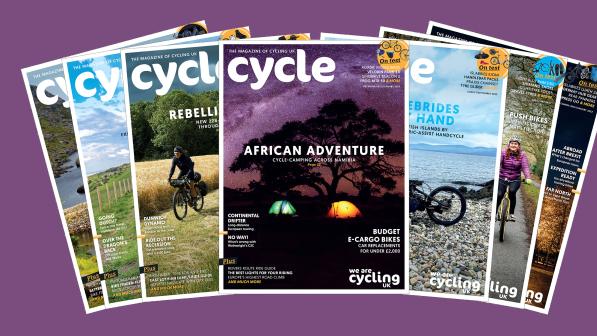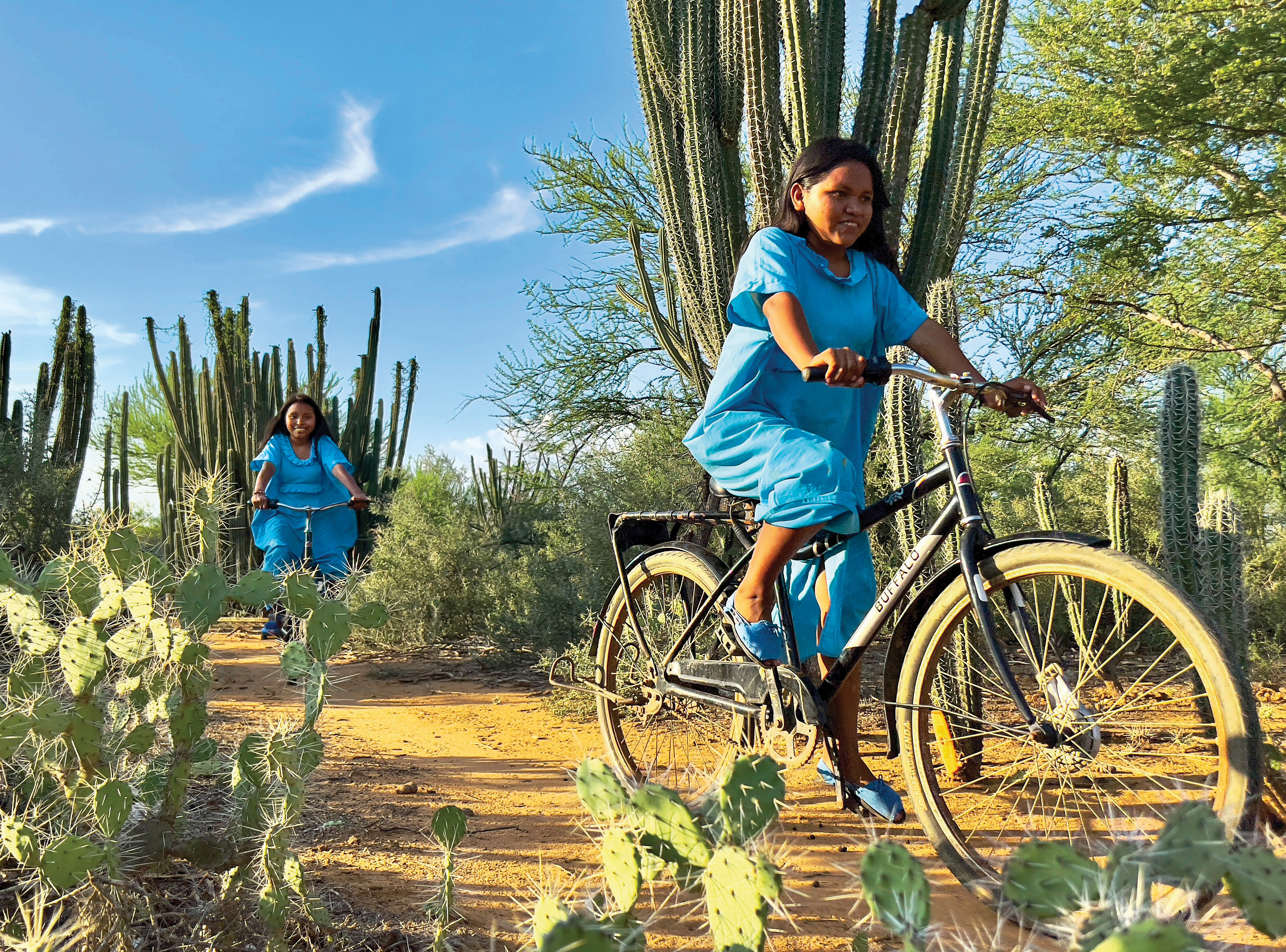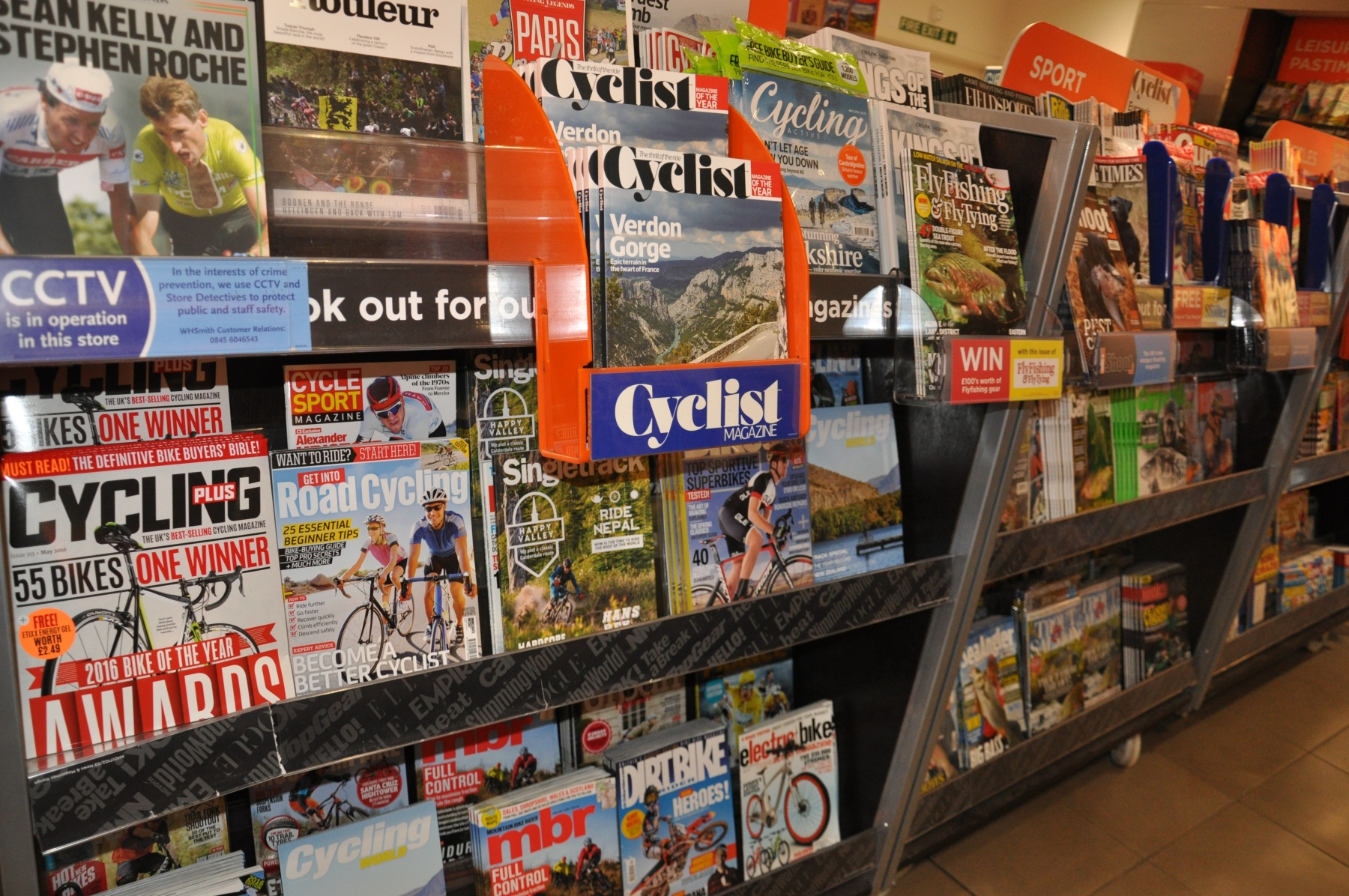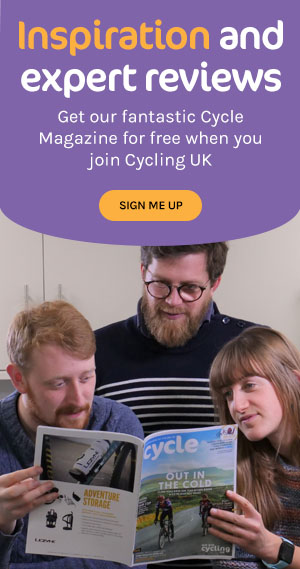Would you like to write for or be a part of Cycle magazine?

Contributions from Cycling UK members are an essential part of Cycle magazine.
Everything you send to the magazine will be read by the editor. But due to the volume of material received, not everything that’s sent will see print, and you may have to wait a while before getting a reply. Your editor is part-time and assesses most contributions in the downtime in between the bi-monthly issues.
Contacting Cycle magazine
Email is best. Please include something in the email header that tells the editor what it is – for example, Travellers’ Tales, Letters, Cyclopedia, etc. You’ll receive an automated reply pretty much immediately. Check your email’s junk file if you haven’t seen it. If your email requires a response that the automated reply doesn’t cover, you’ll receive a separate email from the editor. This will not be immediate. As noted, contributions are generally assessed in the downtime in between issues.
If you’re sending something by post, use the normal Cycling UK office address but add the words ‘Cycle magazine’. Please tell us on the envelope what the letter relates to – for example, Letters, Cyclopedia, Travellers’ Tales, etc. So a contribution for the letters pages would look like this:
Cycle magazine letters
Cycling UK
Parklands
Railton Road
Guildford
GU2 9JX
Do I want the editor?
The editor can only deal with correspondence that relates directly to the content of magazine – articles and so forth. Other queries are handled by someone else.
- Missing magazines or general enquiries? Contact Membership. Tel: 01483 238300.
- Cycling UK policy or complaints? Email us or write to the chief executive, Cycling UK, Parklands, Railton Road, Guildford, GU2 9JX.
- Cycling UK group activities? Contact Membership, Cycling UK, Parklands, Railton Road, Guildford, GU2 9JX.
- Cycling UK website? Contact the Comms team Cycling UK, Parklands, Railton Road, Guildford, GU2 9JX.
General information
Digital is best for any contribution as it saves the editor typing time and is far less likely to get mislaid. If you’re sending a contribution by post, typed is best. Handwritten is okay for shorter items such as Letters or Q&As. Cycle doesn't accept faxes.
If you send something in the post that you want returning, include a stamped SAE. Photos, in particular, are sometimes damaged or lost in transit so never send originals unless you have been expressly asked to do so by the editor.
If you’re sending an email, you should receive an automated reply. If you don’t, check that you’ve used the correct email address. If the automated reply doesn’t address your query, in the editor’s opinion, you will receive an additional reply. This may take a while; the editor files all emails and responds to them – sometimes promptly, often not – in date order.
Emails with attached files are fine but please do not send unnamed attachments or attachments larger than 10Mb in total. Unnamed attachments are a common way to spread viruses and they will generally be deleted – as will any file that the editor’s email filters consider to be spam. Huge emails sometimes fail to arrive.
The editor’s computer can read many different word processing and image file formats but there are some that it won’t recognise. You don’t have to stick to Word (.doc or .docx) and jpeg (.jpg) files but should use something that’s at least fairly common. Better still, put the text in the body of the email unless you're sending an article.
Word processing files should contain only words. Keep any formatting simple. Bold text, italics and capitals are fine. Anything fancier will be stripped out immediately any editing begins. Do not embed picture files into word processing documents. At best, we can cut and paste such images into an image file; at worst, we can't use them at all. Send pictures as individual image files (see below for guidance).
Letters
Each issue the editor selects a representative cross-section of letters and emails for the letters pages. Many more letters are received than are published so there’s no guarantee that yours will see print. However, all letters and emails to the editor are assumed to be for publication unless you state otherwise. Letters should include your name and membership number. We reserve the right to edit letters for reasons of space, clarity or libel.
You can use the letters pages to comment on any cycling topic but if you have a specific complaint or query about Cycling UK policy that you want answering, you should address it to the relevant national office staff member.
Some general rules for letter content:
- Be concise. Well written shorter letters are more likely to be printed than longer ones. Letters longer than 150 words long are rarely printed unedited.
- If you’re expressing likes or dislikes about the magazine, try to be specific.
- Don’t send poetry.
- Try to be either timely (the letter relates to a letter or article in the previous issue) or timeless (the letter is about cycling, not the content of an earlier magazine).
Q&A
As with letters, we are only able to feature a sample of the queries that receive. Queries that do not appear in the magazine receive only an acknowledgement.
Travellers’ Tales
Four Travellers’ Tales typically appear every issue and they are always written by Cycling UK members. No payment is made for those that are printed. A Traveller’s Tale article should be 250-300 words long and must be accompanied by two or more relevant pictures. Please send a GPX file of your route if you have one. It’s really useful for other members when your article goes online.
Travellers’ Tales are never commissioned. If you’ve got a good idea for one, there’s no need to phone or enquire by post. Just get writing. We print the best of those we receive. Those that aren’t used initially are kept on file for possible future use. If you specifically request that a posted Travellers’ Tales submission be returned, it will be – subject to the inclusion of a stamped SAE.
Travellers’ Tales can be about any trip by bike, and could cover the whole trip or just short episode in a particular trip. If it entertains or inspires other Cycling UK members, anything goes. From a practical point of view, an article that is the right length and has a couple of good pictures and a GPX file to go with it stands a better chance of being published than one that lacks these things.
The most important element, however, is a spark of interest, originality or personality. And all of those things come from the writing. The best advice here is: try to write it like you’d speak it. This isn’t meant literally (we don’t want the article punctuated with ums and ahs). But we do want your ‘voice’. You’re not writing an essay or a policeman’s report, so you don’t need to ‘put your writing head on’.
Try this instead: imagine you’re describing the events to a friend in a cafe or pub. What do you start with? Do you begin by telling your friend how you planned your trip, or do you leap straight in with the edited highlights? Good journalism is just one person speaking to another by a different medium.
Bike finder
What bike should I buy? is one of those questions that comes up time after time. The experts at Cycle magazine can help. Fill in the bike finder form with your requirements and we’ll suggest two possibilities based on your needs.
We select one query for publication in each issue of Cycle. The others won’t be immediately answered but are kept on file for possible future use.
Articles
Articles in Cycle are written by a variety of people: cycling journalists; specialists in a particular field (such as health, for example); Cycling UK staff members; and Cycling UK members like you.
If you’re knowledgeable about a particular subject, you can write about that. Otherwise, the most obvious avenue is to submit a tour report. Most tour reports from members are rejected. That’s not because we don’t want you to write, but because competition is fierce and because picture quality is often not good enough. If you write well, you take decent pictures, and you’re persistent enough, you will get published – and even be paid for doing so.
Touring articles in Cycle are usually around 1000-2000 words long and we will need good quality pictures as well. If you’ve had work published elsewhere, it’s enough to send samples of your published work along with a short précis of the article you propose to write. The editor will decide whether or not to commission you to write your article on that basis.
If you haven’t had work published elsewhere, you will need to write your article ‘on spec’ and hope for the best. Take a look at the touring articles that are printed in Cycle. Re-read them. They represent that kind of work the editor is looking for.
Remember that your aim as a writer is not to write what you want to write about but to write what other Cycling UK members want to read about. Many tour reports fall at this first fence.
The comments in Travellers’ Tales (above) about writing apply to articles too. Again, please send a GPX file of your route if you have one. It’s really useful for other members when your article goes online. Here are some additional points to note:
- If the story does not interest you, it will not interest the reader. Always make it interesting.
- Grab the reader from the opening paragraph. Long, involved, or just plain dreary opening paragraphs dissuade readers from reading your article.
- If you wouldn’t say it, don’t write it. Be conversational, but be correct.
- Long sentences and long paragraphs confuse the reader. Avoid.
- Avoid using a long word if a short one will do.
- Don’t over-write. Keep to the required word count.
- Don't pad. Padding reads like padding.
- Do not be afraid to go into detail if you need to do so.
- Do not use the passive if you can use the active (eg ‘X opened the door’, not ‘The door was opened by X.’)
- Be wary of sounding stuffy, pompous or arrogant – it will offend the reader.
- Avoid slang or clichés (unless you’re giving a direct quote).
- Use specific, concrete words not general, abstract ones (tea break, not ‘interval for refreshments’).
- Don’t tell us what you had to eat on tour unless it’s relevant or interesting.
- Do not use foreign words unless in a direct quote or product name.
- Try to eliminate jargon. Always go for colloquial English.
- Take pride in accuracy. Never guess, particularly where names, phone numbers or prices are concerned. If in doubt, don't just leave it out – find out.
A final note: sometimes even really good articles are rejected through no fault of the writer. It often seems to happen that two articles about, say, Iceland will turn up one after the other. While it’s possible we’d print a combined article, it’s unlikely that two articles on broadly the same tour will appear one after the other.
Charity rides: a special note
"Are you interested in my 1,000 mile charity ride?" Probably not. Let me qualify that. I’m indifferent to the fact that it is a charity ride. That doesn’t mean that charity rides never appear in the magazine, only that they’re judged on their merits as an article and not on their charitable worthiness.
Don’t forget:
- Cycling UK members go on cycle tours for pleasure. Enjoyment is the raison d’être. Sponsorship as a prime reason to do a ride (as opposed to a useful extra element to a ride you’d want to do anyway) is to some extent anathema to the cycle touring mindset. To a keen cyclist, ‘sponsored ride’ sounds like ‘sponsored sunbathe’.
- Cycling UK is itself a charity. So other charities aren’t much promoted in articles in the magazine.
- You need some thread to hold the article together apart from the charity aspect. A good article that mentions the charity in passing and ends with a web link to it is fine. An article that focuses on the charity and all the good work it’s doing is not: that’s an article for the charity itself and its media, and not for Cycle.
Sending pictures to Cycle
You don’t need to be a photography expert or have a fancy camera to submit pictures to Cycle. Send pictures digitally if possible. They won't get lost or damaged and it means we don't have to scan them. Prints are okay for things like letters or even Travellers' Tales, if that's all you have.
The pictures should be relatively sharp, of course, and a good proportion of them should have one or more cyclists in shot. A bike leaning against a fence is a poor substitute. If there are no other cyclists, the solution is to get at least some pictures with you in them. This is easy (but time consuming, since you'll end up with several pictures where you're not quite in shot!) using a digital camera's timer function (which even compact cameras have these days) and a cheap tripod like a Joby Gorillapod. You can wrap it around trees and fence posts etc. to set up shots.
If you’re taking a landscape shot, it often helps to have a cyclist in the foreground even if the cyclist is not the main subject of the photo. Tiny cyclists in the distance rarely add much to a picture (unless the picture is excellent in itself), and with a fixed-focus camera you don’t need to be that far away for your subjects to look tiny. With a fixed focus camera, get in close so that the subject fills a good proportion of the frame.
For touring photos, take shots that include local details to avoid that ‘could have been anywhere’ look. And look out for opportunities to get an unusual, dramatic perspective. You can often get interesting pictures by changing the point-of-view of the photograph. Lie on the floor. Kneel down by the verge. Get up on that bridge.
Give each photo a short description so that it can be captioned. If it’s a print, write on the back. If it’s a computer file, either: change the name of the file to the photo’s title; or, if you know how, add a fuller description to the photograph’s metadata.
Photographic media
Digital is best. We print at 300 dots per inch, whereas a picture will look fine on many computer screens at just 72 dots per inch. A ‘dot’ is the same as a ‘pixel’. To work out how large we can use one of your digital pictures, all you need to do is divide the number of pixels by 300. That’s the size we can use it at in inches. So if your picture is only 600 pixels wide, we can only print it two inches wide. Conversely, a full page A4 picture would need to be approximately 3600 pixels high by 2500 wide. There's a bit of flexibility with this, but it's a good guide.
As noted above, we can open most image formats. The default image format is ‘jpeg’ or ‘.jpg’. Now that high-resolution cameras are the norm, jpegs can be used for print purposes. For while the jpeg format is ‘lossy’, when you start off with a sufficiently high resolution image it doesn’t matter if there’s some compression of the image. That being the case, jpegs are best saved at ‘maximum resolution’ if you’re supplying them to Cycle.
If you’re sending images by email, you’ll run into problems if you send large files. Any single email that is bigger than 10Mb may not reach the editor. It’s better to use a file transfer service such as WeTransfer or Dropbox.
If you’ve been asked to send high-resolution images by the editor, and if email is the only practical way you can send them, send them through one image at a time, on a succession of emails. If you haven’t, it’s best to send through a selection of small, low-resolution images by email instead. The editor can then see what’s available and request high-resolution versions of any images, if they’re needed.
If you’re using an image-sending facility such as WeTransfer you can send as many images as you like at whatever size. You can also set up a free image gallery for your pictures at flickr.com (and lots of other places) where they can be downloaded.
Advertising
Do you want to get your product in front of more than 85,000 cycling enthusiasts? Cycle magazine has the highest circulation of any cycling magazine in the UK – twice as high as that of its nearest rival at 51,000. Many members pass their magazine on to cycling friends, bringing the readership to 86,700.
There is a range of options and packages for advertising to suit all. Email Bevan Fawcett or call 020 3198 3092 to discuss what’s available. Our downloadable media pack has further information.








